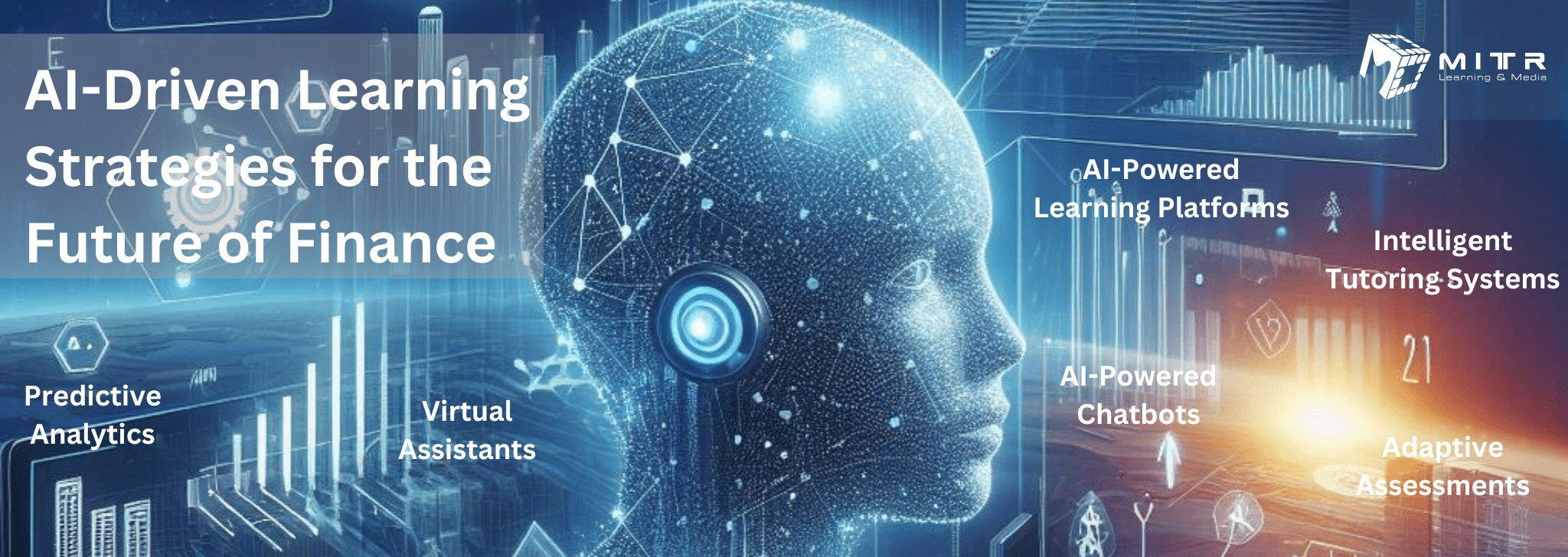AI-Driven Learning Strategies for the Future of Finance
In the dynamic world of finance, continuous learning is paramount for organizations to stay competitive and adapt to rapid changes. Leveraging artificial intelligence (AI) in employee education offers a transformative approach to skill development and adaptation. By incorporating AI into their Learning and Development (L&D) initiatives, financial institutions can optimize learning strategies, foster professional growth, and drive innovation within their workforce.
Role of AI in Employee Learning:
- Personalized Learning Paths: L&D teams can utilize AI to craft personalized learning paths for employees, aligning with their roles, skill levels, and career aspirations. By analyzing data on individual learning preferences, performance, and behavior patterns, AI ensures that each employee receives tailored learning experiences, maximizing engagement, retention, and skill development.
- Adaptive Assessments: With AI-powered assessments, L&D teams can dynamically adjust the difficulty and content of assessments based on employees’ responses. This adaptive approach provides real-time feedback, identifies knowledge gaps, and enables targeted skill development. For instance, AI can analyze an employee’s performance in a financial modeling assessment and adjust the subsequent questions or simulations based on their strengths and weaknesses.
- Predictive Analytics: AI-driven predictive analytics empower L&D teams to anticipate future learning needs and market trends. By analyzing vast amounts of data on employee performance, industry developments, regulatory changes, and emerging technologies, teams can proactively design learning initiatives that equip employees with the skills and knowledge needed to thrive in an evolving financial landscape.
- Virtual Assistants: AI-powered virtual assistants serve as invaluable resources for employees, offering instant support and guidance on complex financial concepts and procedures. These virtual assistants enhance the efficiency of learning by providing on-demand access to information, troubleshooting common challenges, and facilitating self-paced learning. For example, a virtual assistant could guide an employee through a complex financial modeling process or provide explanations on regulatory changes.
- Gamification: L&D teams can leverage AI-driven gamification to make learning experiences more engaging for employees. By incorporating elements such as leaderboards, badges, and rewards, teams foster a sense of competition and motivation among employees, driving active participation and knowledge retention. AI algorithms can personalize gamification elements based on individual preferences and learning styles, further enhancing engagement.
How L&D Teams Utilize AI:
- Curriculum Design: AI enables L&D teams to design dynamic and adaptive learning curricula that reflect the evolving needs of the organization and its employees. By harnessing AI algorithms to analyze industry trends, employee feedback, performance data, and regulatory changes, teams can curate relevant and engaging learning content that supports continuous skill development.
- Content Curation: AI automates the process of content curation, allowing L&D teams to efficiently gather and organize a diverse range of educational resources for employees. From articles and videos to interactive simulations and case studies, AI-driven content curation ensures that employees have access to high-quality learning materials that align with their learning objectives and preferences.
- Performance Analytics: With AI-powered performance analytics, L&D teams gain actionable insights into employee learning progress and outcomes. By tracking key metrics such as completion rates, quiz scores, skill proficiency levels, and knowledge retention, teams can identify areas of strength and opportunity within the organization, enabling data-driven decision-making and continuous improvement of learning initiatives.
- Continuous Improvement: AI facilitates continuous improvement of learning initiatives by providing real-time feedback and performance data. By leveraging AI algorithms to analyze employee interactions with learning materials and platforms, teams can iterate on content, delivery methods, and learning strategies to enhance effectiveness and relevance over time.
Examples of AI in Employee Learning:
- AI-Powered Learning Platforms: Employee learning platforms equipped with AI capabilities, such as Degreed, Coursera, and Udacity, offer personalized learning experiences tailored to individual needs and preferences. These platforms leverage AI algorithms to recommend relevant courses, assess skill gaps, and track progress, enabling employees to take ownership of their learning journey.
- Virtual Reality (VR) Simulations: AI-driven VR simulations provide immersive learning experiences for employees, allowing them to practice financial decision-making in realistic scenarios. For instance, JPMorgan Chase has developed a VR trading simulation that replicates the high-pressure environment of a trading floor, enabling employees to hone their skills in a safe and controlled environment.
- AI-Powered Chatbots: Employee-facing chatbots equipped with AI capabilities, such as those developed by companies like Raven AI and Aimendo, offer instant support and guidance on a wide range of topics, from basic procedural queries to complex financial concepts. These chatbots provide employees with on-demand access to information and resources, enhancing learning efficiency and productivity.
- Intelligent Tutoring Systems: AI-powered intelligent tutoring systems, like those offered by companies like Carnegie Learning and Knewton, provide personalized instruction and feedback to employees based on their individual learning needs and progress. These systems can identify knowledge gaps, provide targeted explanations and examples, and adapt the learning content and pace accordingly.
Conclusion
L&D teams in financial organizations can harness the power of AI in employee learning to design personalized, adaptive, and engaging learning experiences that empower employees to thrive in a rapidly changing industry. By leveraging AI for curriculum design, content curation, performance analytics, and continuous improvement, teams can drive organizational growth and innovation through the development of a highly skilled and knowledgeable workforce. As AI technologies continue to evolve, the potential for transforming employee learning in finance is vast, enabling organizations to stay ahead of the curve and cultivate a culture of continuous learning and professional development.
- Adhip Panditahttps://www.mitrmedia.com/resources/blogs/author/adhipp/
- Adhip Panditahttps://www.mitrmedia.com/resources/blogs/author/adhipp/
- Adhip Panditahttps://www.mitrmedia.com/resources/blogs/author/adhipp/
- Adhip Panditahttps://www.mitrmedia.com/resources/blogs/author/adhipp/





Leave a comment